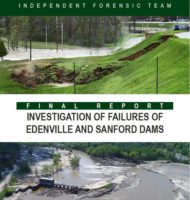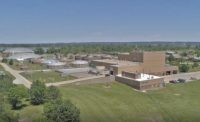Investigations
Michigan Dam Failures Caused by Rapid Liquefaction of Downstream Sand Embankments
2020 Failures do not initially look as if FERC, Boyce Hydro dispute over maintenance was a factor

An interim report from the Association of State Dam Safety Officials reports that a clear factor in the failures of two dams built in the 1920s was static liquefaction (flow) instability of saturated, loose sands in the downstream section of their embankments. The Edenville and Sanford Dams along the Tittabawassee River in north central Michigan failed on May 19, 2020, after two days of heavy rain, resulting in flooding and property damage.
Static liquefaction has rarely been observed in dam failures and is more commonly associated with earthquakes, according to the forensic team. It occurs when the mobilized shear strength in saturated, loose sand decreases rapidly to values significantly less than the applied static shear stresses, resulting in a force imbalance. The sand quickly liquefied, became mud and then accelerated the velocity of the already fast-moving water with its mass.
The five-member independent forensic team from ASDSO began its investigation August 2020, tasked to look at the failure of the two dams, the Edenville Dam first followed by the Sanford Dam and to discern what physically happened. In a press briefing John W. France—the lead of the independent forensic team investigating the dam failure and a registered professional engineer who has worked for the U.S. Department of the Interior, Bureau of Reclamation, the U.S. Army Corps of Engineers, BC Hydro, and Brookfield Renewable Energy—said that it will be very difficult to tell if there were design or construction issues with the way both dams were designed and constructed in the '20s because the team only has archival photos of the construction, and it predates the establishment of geotechnical engineering as a services profession. He also said that inspections done by the Federal Energy Regulatory Commission, which was responsible for regulating both dams, and by ownership would not have likely looked at downstream embankment static liquefaction as a potential cause of future failure. The team was able to draw several conclusions from a video of the Edenville Dam failure taken by a local resident.
"That video shows that a very rapid failure of the downstream section of the Edenville Dam at about 5:35 in the afternoon on May 19," France said. "A 40-to-80-ft-wide section of the downstream section of the embankment appears to move downstream very quickly in a matter of about 10 seconds."
France explained that a remnant upstream section of the embankment stood for another 10 seconds or so before water started to flow through it and widened the breach in the dam out over the next few hours. The unrestrained water then flowed down to the Sanford Dam and the water it was holding back quickly began to rise and roughly two hours after the failure of the Edenville Dam, the water level at Sanford Dam reached a fuse-plug spillway.
"The amount of water flowing in from the failure of Edenville Dam was just more than those spillways could handle," France says. "A bit over two hours after the Edenville dam failed, the water went over the top of Sanford Dam. Embankment dams do not hold up very well when water flows over the top of them."
Human Factors
France says that, while ASDSO's investigation into human factors that may have played a role in both dams' failures continues, that, at this point, it does not look as if the ongoing dispute between the two dams' owner, Boyce Hydro, FERC and local residents over who should pay for repairs to and ongoing maintenance of the two dams played any role in their failure. FERC had revoked the Edenville Dam's license for power generation in September, 2018, after more than a decade of negotiations with Boyce Hydro over maintenance and modernization that the regulator said was necessary to keep the 1925 hydroelectric dam in service.
France said the engineering equation of force equals mass times acceleration is the operative one to understand how the force imbalance at Edenville Dam developed. "Because of that low strength (of the embankment), that force imbalance creates an acceleration of the mass, which creates velocity, which creates the very high-speed, slow type of failure that we saw at Edenville," he said.
"By 'high-speed, slow type of failure,' the video showed, France said, that the downstream embankment of Edenville Dam was first breached around 5:35 PM on May 19 when the 40-to-80-ft-wide section of the downstream embankment appeared to move downstream in a space of around 10 seconds. A remnant upstream section of the embankment stood for another roughly 10 seconds before water started to flow through it. The rest of the embankment and then the dam, itself, failed over the next few hours.
Except for the collapse of recent tailings dams in mines in Brazil and elsewhere, the phenomenon of loose sand downstream liquefaction has not been widely reported.
"The thing I want to reinforce again is that this particular physical mechanism that we're talking about is one that was not something that regulators or practicing engineers were looking at," he said. "If one looks at the literature in geotechnical engineering or solid mechanics or stability analysis or dam engineering, what you generally find is references say that except for earthquakes, sand would not behave the way it did in this failure." One exception, he mentioned, is that "our tailings dam colleagues" have begun to look at this more closely.
Last year, ASDSO reported that the failure of the Spencer Dam in Nebraska was the result of ice runs in extreme rain conditions, which were also not well understand prior to their report on the failure.
"We learned something at a cost, but it wasn't a cost of lives, which is good," he said. That's part of engineering, he notes, "that we learn some things when they do not perform the way we expect them to."
France said that the forensic team's final report will be out in early 2022, and it will take into account the role that human factors played in the failure. The full interim report can be found on the homepage of the association's website, damsafety.org.



